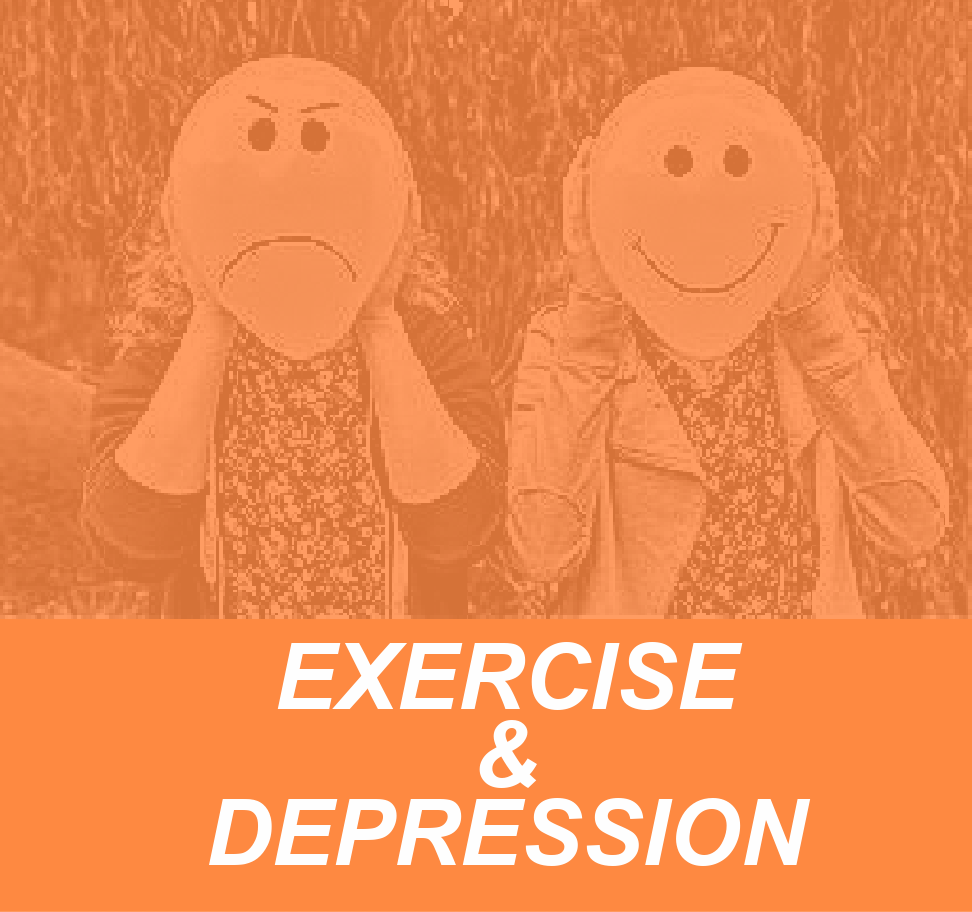Depression is the “common cold” of psychological disorders. The World Health Organization considers depression a high-priority concern and most everyone has been depressed or knows someone who has been depressed at some time in life. While there may be different causes, triggers, and etiology of the experience of depressive symptoms, we as fitness professionals have one powerful tool at our disposal to help our clients and loved ones: exercise. The correlation between exercise and depression has been clearly demonstrated; here’s how personal trainers can play a role.
Signs of Clinical Depression
Symptoms of depression include sleep disturbances, loss of appetite or overeating, and anhedonia (inability to experience pleasure). While it comes in different forms and intensities, some of its characteristics are enduring.
Depressed people think in different ways from their non-depressed counterparts. Their neuro-chemistry is different. They may have low self-esteem and are most likely inactive much of the time.
Depression is often treated with drugs that activate neuronal communication, usually by inhibiting the reuptake of key neurotransmitters, like serotonin. Mood is elevated as a result of these changes in the nervous system.
Psychotherapy is also used as a treatment, sometimes in combination with medication. One effective form of psychotherapy is cognitive-behavior therapy in which the patient is prompted to change their thoughts and then, how they respond to their thoughts.
For example, one might observe and recognize the faulty thought of, “My life is so much harder than everyone else’s,” they are taught to reframe it and instead think, “Life can be hard for everyone, and I can’t know everyone’s journey. I have challenges I’m facing but I have the strength to face them.”
The behavior hallmark of depression is inactivity. Depressed people are tired, lethargic, and unmotivated. In severe cases, they have difficulty getting up, starting the day, and doing the essential activities life requires.
Good personal trainers are aware that their depressed clients are reaping benefits at the health club beyond improved levels of general health and physical fitness. Exercise has a direct and positive effect on an individual suffering from clinical depression.
Post-Partum Depression
Welcoming the addition of a precious new “bundle of joy” into the family is always a celebrated life event. Amid such elation, however, many new mothers experience a period of post-partum depression, often referred to as “the baby blues”. This can be quite a confusing time since many mothers wonder what could possibly be causing a deep sadness when one of the greatest events in their lives just occurred.
Similar to clinical depression, classic post-partum depression can be characterized by sadness/episodes of weeping, irritability, fatigue, increased sensitivity, a sense of hopelessness and isolation, and the loss of interest in formerly pleasurable activities. While much of this can easily be attributed to the demands of a new baby, altered levels of circulating hormones, and a decrease in the amount of rest to which one has become accustomed prior to delivery, more severe post-partum psychosis can last for months and become all-consuming for the new parent, interfering with the bonding process and overall caring for the infant.
Research has indicated that exercise may have a profound effect on helping to ease the symptoms of post-partum depression. Since many women choose not to consume any medications during the first few months after delivery, owing in large part to the transfer of most drugs into breastmilk, taking advantage of the antidepressant effects of exercise seems to be a prudent course of action.
A study by Dunn and colleagues (2005) examined the efficacy of exercise as a treatment for depression, along with the dose-response relationship of exercise and reduction in depressive symptoms. They concluded that moderate to intense physical activity, performed 3-5 times a week, heralded significant reductions in symptomatic women. In addition, some early results from a study in Australia have suggested that a stroller walking program has helped alleviate the symptoms of postpartum depression.
The post-partum depression symptoms can be exacerbated if a new mother already has a history of clinical depression. Preliminary data from a study from the UK suggest that aerobic exercise has a significant positive effect on mood in perinatal women, and that this pattern can have a heightened effect on these same women in the period after delivery. If one is prone to bouts of depression, engaging in an exercise program during the pregnancy would prove to be beneficial, not only for the health benefits but to mitigate the onset of a post-partum depressive state.
Why Does Exercise Work For Depression?
The mechanism whereby exercise facilitates mood is not a new concept. Upon engaging in any form of exercise, the body releases chemicals called endorphins. Not only do endorphins interact with receptors in the brain that reduce the perception of pain, they are also responsible for the triggering of a morphine-like feeling of euphoria. Euphoria is accompanied by a more positive, energized outlook on life, precisely what an overwhelmingly saddened new mother needs. An added benefit is that, unlike with the use of morphine or similar drugs, activation of these particular brain receptors by endorphins does not lead to addiction.
For some women who are quite conscious of their body image post-partum, the presence of residual abdominal tissue can be a cause of much anxiety and body dysphoria. Engaging in a regular exercise program can help restore muscle tone in the midsection as well as boost the body’s overall metabolism, further facilitating rapid loss of “baby weight” and restoring the new mom to a happier, more fit, and healthy place.
While exercise has been shown to be an effective mechanism in helping to alleviate the symptoms of post-partum depression, it should be noted that in some extreme cases, this depression can become severe. In extreme cases of depression, exercise alone most likely will not eradicate the problem. Any woman suffering from post-partum depression may experience fleeting thoughts of suicide or of harming her baby. A woman with postpartum psychosis, however, may feel as though she has to act on these thoughts. If this pattern of behavior is suspected, a medical professional should be consulted immediately.
How Exercise Can Improve Depression
1. Exercise is active. Since the behavioral hallmark of depression is inactivity, it is difficult to be both exercising and depressed. Exercise can help clients beat a bad mood and spiral into a more positive space, or if nothing else, be a distraction from negative thoughts and feelings.
2. Exercise increases self-esteem. Performing new movements and exercising makes a person feel good about themselves. There may be a sense of accomplishment from simply start and then maintaining, and if any visible or physical measures improve, that can certainly provide a boost in self-esteem.
3. Improved sleeping and eating patterns are often associated with movement. Exercise can help us sleep more soundly, and it can improve the functioning of our digestive systems, thus reversing a side effect of depression.
4. Positive neurochemical changes can be triggered. Research shows that exercise changes our physiology, including the neurochemical activity of the brain and nervous system. It stimulates the release of the brain’s natural opiates, the endorphins, thereby making us happier.
5. Exercise can be fun! Once a regular routine is established (arguably the hardest part), people usually look forward to their workouts. The joy that comes from moving and stretching and “pumping iron” combats anhedonia. Life becomes pleasurable again!
6. Social support and fitness. It is difficult to become “regular” at most health clubs without making friends. Social support is one of the most effective ways to help individuals stay healthy and combat disease. Depressed individuals can benefit tremendously from social interaction at the gym, in group exercise classes, or even from web-based competitive groups like those found on the Peloton platform.
7. Cognitive changes ensue. While establishing exercise routines, the mind leans into stability. Stability in the routine can decrease instability in the way we think and feel. When interacting with a trainer, workout partner, or club member, there is a real opportunity to get out of our own inner dialogue and change the way we think by virtue of simply listening to the thoughts of others. Positive reinforcement from others can also pave the way to self-worth and new thinking. “Way to go!” “Good job!” These comments from others can become part of our inner dialogue. It is difficult to be depressed when we are saying positive things in our own heads.
[sc name=”ms” ][/sc]
Post-partum and clinical depression are not at all uncommon occurrences. Personal trainers should be ready to recognize when symptoms of clinical depression are present and, certainly, keep a watchful eye on new mothers for signs of post-partum depression.
References:
1. Nordahl, Karen M.D. Urbanbaby and Toddler Magazine, Winter 2005-06
2. Daly, Amanda J. PhD. et al “The Role of Exercise in Treating Post-Partum Depression: A Review of the Literature” Journal of Midwifery & Women’s Health, Volume 52, Issue 1, January-February 2007, pages 56-62
4. Dunn, A.L., Trivedi, M.H., Kampert, J.B., Clark, C.G., Chambliss, H. G., 2005. Exercise treatment for depression: efficacy and dose response. Am. J. Prev. Med. 28: 1-8.
5. Koltyn, K.F., Schultes, S.S., 1997. Psychological effects of an aerobic exercise session and a rest session following pregnancy. J. Sports Med. Phys. Fitness 37 (4), 287-291.
6. Heh, S.S., Huang, L.H., Ho, S.M., Fu, Y.Y., Wano, L.L., 2008. Effectiveness of an exercise support program in reducing the severity of postnatal depression in Taiwanese women. Birth . 35 (1), 60-65.




